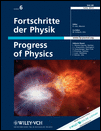
FORTSCHRITTE DER PHYSIK-PROGRESS OF PHYSICS
Scope & Guideline
Championing Excellence in Physics Scholarship
Introduction
Aims and Scopes
- Quantum Gravity and String Theory:
The journal regularly publishes research on quantum gravity, including string theory, holographic dualities, and effective actions that bridge these fields with broader physics concepts. - Black Hole Physics and Cosmology:
A significant focus is on black hole thermodynamics, singularities, and their implications in cosmology, including studies on gravitational waves and dark energy. - Geometric and Algebraic Methods in Physics:
There is an emphasis on the application of geometric and algebraic methods, such as noncommutative geometry, tensor calculus, and topological quantum field theories, to investigate fundamental physics problems. - Emerging Theoretical Frameworks:
The journal explores new theoretical frameworks, including modified gravity theories, thermodynamic models of black holes, and anisotropic cosmological models, reflecting a trend toward innovative solutions to longstanding problems. - Interdisciplinary Approaches:
Research often intersects with fields such as quantum information, computational methods in physics, and the application of machine learning techniques to theoretical problems.
Trending and Emerging
- Quantum Information and Computation:
There is an increasing emphasis on quantum information theory, including quantum error correction, entanglement studies, and the application of quantum computing principles to solve complex physical problems. - Modified Gravity Theories:
Research on modified theories of gravity, such as f(R) and f(Q) theories, is gaining traction, indicating a shift towards exploring alternatives to general relativity in cosmological and astrophysical contexts. - Thermodynamics of Black Holes:
An emergent theme revolves around the thermodynamic properties of black holes, including studies of entropy, Hawking radiation, and their implications for quantum gravity. - Geometric and Topological Methods:
The application of geometric and topological methods in theoretical physics is becoming more prevalent, with research focusing on new mathematical frameworks that enrich our understanding of physical phenomena. - Interconnectedness of Physics Disciplines:
There is a growing trend towards interdisciplinary research that connects various branches of physics, such as linking quantum mechanics with general relativity, and applying concepts from statistical mechanics to cosmology.
Declining or Waning
- Classical Cosmological Models:
There has been a noticeable decline in publications focusing on classical cosmological models, such as those based on standard general relativity, compared to more innovative approaches involving modified theories of gravity. - Standard Model of Particle Physics:
Research directly related to the standard model, such as detailed studies of its limitations or minor extensions, is less frequent, possibly overshadowed by more speculative theories like supersymmetry and quantum gravity. - Non-relativistic Quantum Mechanics:
The exploration of traditional topics in non-relativistic quantum mechanics has waned, as the journal's recent focus has shifted toward relativistic frameworks and quantum gravity.
Similar Journals
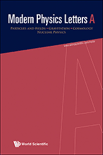
MODERN PHYSICS LETTERS A
Connecting Innovators in Astronomy and High Energy PhysicsMODERN PHYSICS LETTERS A, published by World Scientific Publishing Co Pte Ltd, is a distinguished journal in the field of physics that serves as a pivotal platform for researchers, professionals, and students alike. With ISSN 0217-7323 and E-ISSN 1793-6632, the journal has gained international acclaim for its contributions to Astronomy and Astrophysics as well as Nuclear and High Energy Physics. The journal is ranked in Q3 for both Astronomy and Astrophysics and Nuclear and High Energy Physics, showcasing its relevance in these areas, while also achieving a Q2 ranking in the broader category of Physics and Astronomy (miscellaneous). Spanning from 1996 to 2024, MODERN PHYSICS LETTERS A promotes open dialogue and dissemination of pioneering research findings and innovative theories. While the journal operates without an open access option, its rich content is easily accessible through various academic databases, ensuring that vital research is shared widely among the scientific community. Situated in Singapore, this journal plays an essential role in the continuous advancement of the physics discipline, fostering collaboration and knowledge sharing among global researchers.
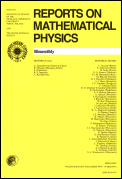
REPORTS ON MATHEMATICAL PHYSICS
Bridging Theories: Where Math Meets PhysicsREPORTS ON MATHEMATICAL PHYSICS is a distinguished journal published by PERGAMON-ELSEVIER SCIENCE LTD, focusing on the intricate interplay between mathematics and physics. Established in the United Kingdom, this journal has been contributing to the academic community since its inception, publishing significant research findings that explore the theoretical underpinnings of physical phenomena. With an ISSN of 0034-4877 and an E-ISSN of 1879-0674, the journal maintains a consistent publishing history, converging research from 1970 to 2024. It is currently ranked Q3 in both Mathematical Physics and Statistical and Nonlinear Physics categories, reflecting its commitment to maintaining a high standard of scholarly work. Although it lacks Open Access options, its targeted audience of researchers, professionals, and students will find invaluable insights into advanced mathematical methods, statistical applications, and innovative approaches in physics. With its esteemed reputation and critical role in the field, REPORTS ON MATHEMATICAL PHYSICS continues to be an essential resource for those seeking to deepen their understanding of mathematical applications in physical systems.

Universe
Empowering Researchers to Illuminate the Cosmos.Universe is a distinguished peer-reviewed journal published by MDPI, specializing in the dynamic fields of Physics and Astronomy. Established in 2015, this Open Access journal has rapidly gained recognition, achieving a prestigious Q1 quartile ranking in its category as of 2023. With its E-ISSN 2218-1997, the journal primarily serves the international scientific community, offering a platform for researchers to disseminate innovative ideas and findings. Based in Switzerland, Universe covers a wide range of topics within astronomy and astrophysics, ensuring that cutting-edge research is accessible to an ever-growing audience. Its commitment to open access principles since its inception allows for unrestricted dissemination of knowledge, fostering a collaborative environment essential for scientific advancement. By aligning its objectives with the promotion of high-quality research and interdisciplinary discourse, Universe stands as a vital resource for academics, professionals, and students aiming to contribute to and engage with the ever-evolving landscape of astronomical research.

Science China-Physics Mechanics & Astronomy
Bridging Theory and Application in the Physical SciencesScience China-Physics Mechanics & Astronomy, published by SCIENCE PRESS, stands as a prestigious journal within the Physics and Astronomy domain, particularly recognized for its contributions to the understanding of fundamental and applied physics. With an exhilarating Q1 ranking in the 2023 category and earning a remarkable scopus rank of #21 out of 243, the journal demonstrates its significant impact, being positioned in the 91st percentile of its field. Operating under an Open Access model, it facilitates the broad dissemination of high-quality research, ensuring accessibility for researchers, professionals, and students worldwide. Its scope covers a variety of essential topics in physics and astronomy, promoting a comprehensive understanding of the latest advancements from 2010 through 2024. The journal is a vital resource for anyone aiming to stay at the forefront of research in these dynamic fields, with its prominent address located in Beijing, China, symbolizing its global influence.
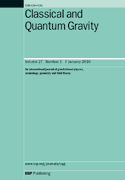
CLASSICAL AND QUANTUM GRAVITY
Bridging Classical and Quantum Perspectives in PhysicsCLASSICAL AND QUANTUM GRAVITY is a prestigious journal published by IOP Publishing Ltd, positioning itself at the forefront of research in the domain of theoretical physics, particularly focusing on gravitational theories in both classical and quantum frameworks. With an impressive Q1 rank in the field of Physics and Astronomy, it has established a significant academic presence since its inception in 1984. This journal offers a platform for disseminating high-quality research findings and critical reviews, playing a pivotal role in advancing our understanding of the foundations of gravitational physics. Researchers and professionals alike will find this scholarly publication an invaluable resource for staying abreast of the latest developments in gravitational theory, quantum gravity, and related interdisciplinary studies. Despite the absence of open access options, its vibrant print and online presence ensures that contributions are accessible to the global scientific community. With a commitment to fostering innovation in an area that remains central to modern physics, CLASSICAL AND QUANTUM GRAVITY continues to attract cutting-edge research that shapes the future of gravitational studies.
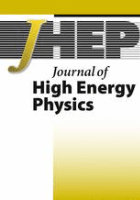
JOURNAL OF HIGH ENERGY PHYSICS
Pioneering peer-reviewed research for a global scientific community.JOURNAL OF HIGH ENERGY PHYSICS, published by SPRINGER, stands at the forefront of research in the fields of nuclear and high energy physics. With an impressive impact factor and a Scopus ranking of #5 out of 87 in its category, it sits comfortably in the 94th percentile of academic journals worldwide. Since its inception in 1997 and transitioning to Open Access in 2014, the journal has committed itself to the dissemination of peer-reviewed, cutting-edge research that fosters collaboration and innovation across the global scientific community. Located in Germany and reaching audiences worldwide, the journal aims to provide a platform for scholars and researchers to share their findings, thus propelling advancements in theoretical and experimental physics. As it converges into 2024, the JOURNAL OF HIGH ENERGY PHYSICS continues to be an essential resource for anyone engaged in this dynamic field of study.
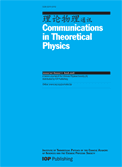
COMMUNICATIONS IN THEORETICAL PHYSICS
Pioneering research for a deeper understanding of physical laws.COMMUNICATIONS IN THEORETICAL PHYSICS is a distinguished journal published by IOP Publishing Ltd, focusing on the broad and evolving field of theoretical physics. With an ISSN of 0253-6102 and an E-ISSN of 1572-9494, this journal provides a platform for the dissemination of innovative research that contributes to the understanding of complex physical concepts. Situated in the United Kingdom, it has established itself as a pivotal resource from 1996 to 2024, achieving a commendable Q2 ranking in the category of Physics and Astronomy (miscellaneous) for 2023. With a Scopus ranking of #18 out of 81 in its category, demonstrating a 78th percentile, this journal plays a crucial role in enhancing scholarly communication among researchers, professionals, and students alike. Although it does not currently offer Open Access options, the journal's comprehensive scope and commitment to high-quality peer-reviewed research underline its significance in the scientific community, making it an essential reading for anyone engaged in theoretical physics.

Journal of Cosmology and Astroparticle Physics
Advancing Knowledge in Cosmology and BeyondThe Journal of Cosmology and Astroparticle Physics (ISSN: 1475-7516) is a premier publication in the field of astronomy and astrophysics, dedicated to advancing our understanding of the cosmos through innovative research. Published by IOP Publishing Ltd in the United Kingdom, this journal has established itself as a vital resource for researchers, professionals, and students alike, with an impressive Scopus rank of #11/90, placing it in the top 12% of its field. The journal aims to foster the dissemination of groundbreaking studies related to cosmology, dark energy, particle physics, and the universe's fundamental structure, making it a key player in shaping contemporary astrophysics discourse. With a Category Quartile of Q2 as of 2023, it continues to attract high-quality contributions that enhance scholarly dialogue. As an accessible platform, it engages a diverse audience interested in the frontiers of astrophysical research, encouraging collaboration and knowledge sharing among the global scientific community.

Living Reviews in Relativity
Dynamic Reviews for a Dynamic UniverseLiving Reviews in Relativity, published by SPRINGER INT PUBL AG, stands at the forefront of the field of relativity, offering a dynamic platform for the dissemination of high-quality, peer-reviewed research. Since its inception in 1998, this Open Access journal has committed to providing continuous updates and comprehensive reviews, making it an indispensable resource for researchers and scholars in the categories of Physics and Astronomy, where it holds a prestigious Q1 ranking. With its impressive Scopus ranking of #1 out of 81 in the Physics and Astronomy (miscellaneous) category, it boasts a remarkable 99th percentile ranking, underscoring its significance in advancing scientific discourse. Operating out of Switzerland, Living Reviews in Relativity serves as a vital conduit for sharing knowledge and insights, fostering collaborative research, and promoting timeless discussions in the ever-evolving landscape of relativistic physics.

THEORETICAL AND MATHEMATICAL PHYSICS
Charting New Territories in Physics ResearchTHEORETICAL AND MATHEMATICAL PHYSICS, published by MAIK NAUKA/INTERPERIODICA/SPRINGER, is a premier journal dedicated to advancing the fields of Mathematical Physics and Statistical and Nonlinear Physics. With an impressive history spanning from 1969 to 2024, this journal serves as a vital platform for researchers, professionals, and students eager to explore cutting-edge theoretical frameworks and mathematical models. Although it currently holds a Q3 ranking in both its categories as per the 2023 metrics and is positioned within the Scopus ranks reflecting its growing influence, the journal continually aims to enhance its impact within the academic community. The publication does not currently provide open-access options, underscoring its collector’s nature in the dissemination of valuable research findings. Submissions are welcomed from diverse areas of theoretical physics, providing a rich and collaborative environment for the exploration of complex phenomena and the development of innovative methodologies.